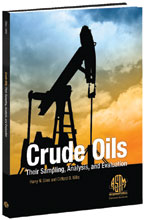
A Manual about Crude Oils
Their Sampling, Analysis and Evaluation
It's all about oil. Crude oil.
Oil is critical to today's industrialized world; an important commodity, it's also volatile in price. Add the critical need for accurate sampling and analysis, and recommendations for a work covering mid- and downstream operations - transportation, interim storage and refining - and the field is set for Manual 68, Crude Oils: Their Sampling, Analysis and Evaluation.
Manual co-author Harry Giles, executive director of the Crude Oil Quality Association and a longtime member of ASTM International Committee D02 on Petroleum Products and Lubricants, says that he and co-author Clifford Mills, a D02 member who is retired from Conoco, began presenting an ASTM training course on the topic in 2005. Course attendees and colleagues encouraged them to write a book. "We felt there was a distinct need for a manual on the same material but in greater depth than could be presented in the course," Giles says. The result is a manual that covers its subject in detail.
Giles emphasizes the need for high quality crude oil sampling, analysis and data reporting according to established standards because of the market proliferation of synthetic, high TAN (total acid number) and extra heavy crude oils. It is critically important, according to Giles, for field operators to adhere to recognized procedures in collecting samples to ensure that they are representative and that the analyst understands potential problems that can be encountered. "If there is an apparent anomalous result, it may be that the sample analyzed may not be truly representative," he says.
With Manual 68, those in the field can gain a better understanding of these topics, including details about available test methods and a discussion of their use, for mid- and downstream operations. The purpose, in every case, is to obtain precise data that will provide an understanding of whether a crude oil can be processed to yield the desired product.
Four sections of the manual have particular importance for users.
- Chapter 3 details the numerous test methods available to determine the properties of whole crude oil. For a specific property, several test methods with differing scope and precision may be available; the book discusses which methods to choose and when.
- A full assay determines the oil's suitability for its purpose, and Chapter 4 covers true boiling point distillation and fractions, or cuts, on which further analyses can be performed.
- The compatibility and stability of crude oil blends or mixes can be determined with methods discussed in Chapter 6. Giles says, "This is increasingly important because of the burgeoning number of crude oil streams in world commerce and the fact that it is often necessary to commingle streams at terminals and refineries."
- Appendix 3 provides summary method information about the standards included in the manual; within the appendix sections on sampling and handling practices and test methods, information appears numerically by the standard designation.
Before its close, the manual addresses analytical methods that need to be developed to better characterize crude oils as well as test methods that need improvements.
Overall, says Giles, "Analytical data must be accurate and reliable as they are the basis for decisions on whether a given crude oil can be effectively processed and yield the desired product slate." Manual 68 assists field and refinery operators, laboratory technicians, chemists and program managers in this process.
 SN Home
SN Home Archive
Archive Advertisers
Advertisers Masthead
Masthead RateCard
RateCard Subscribe
Subscribe Email Editor
Email Editor